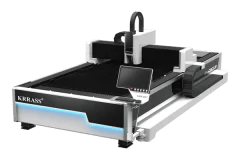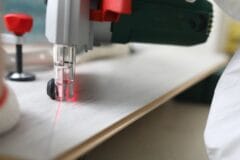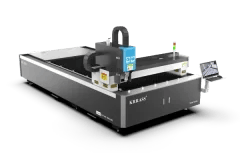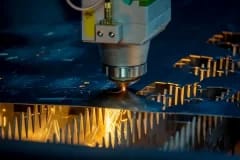The quality of laser cutting achieved by laser cutting machines is subject to a multitude of factors, rendering it a complex interplay. At the heart of the laser cutting process lies the interaction between the laser beam and the materials being cut, categorized into two main phenomena: microscopic and macroscopic.
Microscopic phenomena delve into the intricate quantum reaction processes occurring during laser-material interaction. Meanwhile, macroscopic phenomena encompass material absorption, reflection, refraction, as well as the energy conversion and transmission of laser beams.
Beyond the intrinsic characteristics of the material being processed, hardware-related factors also exert influence on cutting quality. Let’s explore these factors together.
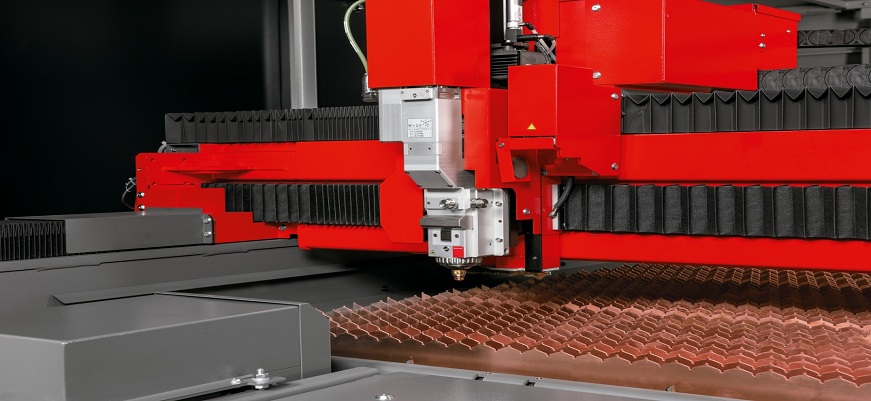
Importance of Quality Control
Quality control has an irreplaceable role in business. Through sampling and process control, organizations can improve their performance. The same is valid for the laser cutting process. However, the question arises as to how to measure the quality of laser metal cutting?
In the previous texts, we emphasized the importance of optimizing the laser cutting parameters, ie the implementation of preventive maintenance of the laser cutter. When it comes to good and high-quality laser cutters, the possibility of anomalies in the cutting process is reduced to a minimum. However, attention should be paid to other important key performance indicators (KPI) that provide feedback on the laser cutting quality level.
Laser cutting norms
As a big part of the business and processes in today’s organizations is standardized and normed, standards that prescribe quality laser cutting parameters have been developed. ISO standard DIN EN ISO 9013: 2002 defines the requirements for laser and other types of thermal cutting. The standard prescribes the control of the following cutting parameters:
- molten metal
- the incision of the cut
- the puncture of the cut
- cut lines
- roughness
Quality control parameters
- Formation of the molten metal – the control of this parameter is usually done by visual inspection of the metal being sliced. The information obtained by checking refers to the focus of the laser beam or the laser cutter optic.
- The incision of the cut– a parameter that depends on the material being cut and is determined by the tolerance for each metal differently. The information obtained by inspecting the incision tells us about the size of the laser beam penetration into the metal.
- The puncture–The puncture of the metal is created due to corrosive action and it can greatly change the quality of the cut. This parameter is usually visually inspected and qualitatively described.
- Cut lines– the cutting lines during laser cutting are determined by the speed at which each position is cut. This parameter is also visually inspected, and the information provided by the inspection speaks about the need to adjust the cut parameters in terms of power and speed.
- Roughness – a parameter that influences the need for additional material handling after laser cutting. The roughness is defined depending on the thickness of the material being cut.
Enhancing the quality of laser cuts can be achieved through consistent maintenance of the laser cutter and fine-tuning of cut parameters. While quality control and parameter optimization play crucial roles, they serve as initial steps toward achieving optimal cutting results. The effectiveness of quality control hinges on the execution of a series of cuts.
When multiple identical cuts are performed, meticulous control of parameters becomes imperative to prevent the repetition of errors across the series. Thus, continual monitoring and adjustment of parameters ensure consistent and error-free cutting operations.
Factors Affecting The Laser Cutting Quality Of Laser Cutting Machines
Beam Characteristics:
There is a significant relationship between the incision width of laser cutting and the diameter of the focused spot. Due to the fact that the power density and energy density of laser irradiation are related to the diameter of the laser spot, in order to obtain a larger power density and energy scale, in laser cutting processing, the diameter of the spot should be as small as possible.
Laser Power:
The magnitude of laser power directly affects the thickness of the steel plate that can be cut. The higher the power, the thicker the material that can be cut. In addition, it also affects the dimensional accuracy of the workpiece, the width of the cutting seam, the roughness of the cutting surface, and the width of the heat affected zone.
Laser power has a significant impact on cutting speed, seam width, cutting thickness, and cutting quality. The power level is determined by the material characteristics and cutting mechanism. Materials with high melting points (such as alloys) and high surface reflectivity (such as copper and aluminum) require higher laser power.
For example, a 1500W Metal Sheet Fiber Laser Cutting Machine cannot achieve the work of a 6000W laser cutting machine. Many times, if you find that the cutting effect is not ideal, it is very likely that you have chosen the wrong laser model.
In laser cutting processing, there is a laser power that achieves the best cutting quality. Under this laser power, there may be phenomena of incomplete cutting or slag hanging. Above this power, it will overheat.
Laser Cutting Speed:
Cutting speed has a significant impact on cutting quality. The ideal cutting speed will result in a relatively smooth line on the cutting surface, smooth material cross-section, and no burrs. When the auxiliary gas pressure and laser power are constant, there is a non-linear inverse relationship between the cutting speed and the cutting seam width. If the cutting speed is too slow, it is easy to cause material overfusion, the cutting seam becomes wider, the heat affected zone increases, and even the workpiece overfusion. Cutting too fast can cause the material to fail to cut through, causing sparks to splash, producing slag in the lower half, and even burning the lens.
Nozzles:
The aperture of the nozzle and the distance between the nozzle outlet and the material surface can all affect the cutting effect.
Focus Position:
The focus position directly affects the width of the incision, cross-sectional roughness, and adhesion of waste residue. The different focal positions result in different beam diameters and focal depths on the surface of the processed material, leading to changes in the shape of the cutting seam and affecting the flow of processed gas and molten metal within the cross-section.
The focus position is the distance from the laser focus to the surface of the workpiece, which directly affects the roughness of the cutting surface, the slope and width of the cutting seam, and the adhesion status of the molten residue. If the focus position is too advanced, it will increase the heat absorbed by the lower end of the workpiece being cut.
At a certain cutting speed and auxiliary air pressure, it will cause the material being cut and the melted material near the cutting seam to flow in a liquid state on the lower surface. After cooling, the melted material will adhere to the lower surface of the workpiece in a spherical shape. If the position lags behind, the heat absorbed by the lower end face of the material being cut will decrease, so that the material in the cutting seam cannot completely melt, and some sharp and short residues will adhere to the lower surface of the board.
Usually, the focus position should be on the surface of the workpiece or slightly lower, but different materials require different requirements. When cutting carbon steel, the cutting quality is better when the focus is on the surface of the plate. When cutting stainless steel, the focus should be around 1/2 of the plate thickness for better results.
Auxiliary gas:
Material cutting requires the use of auxiliary gas, mainly gas pressure and gas type, both of which can affect the roughness of the cutting section and the generation of slag.
In laser cutting processing, auxiliary air pressure plays a role in blowing off slag, cooling materials, and assisting combustion. Auxiliary gases include oxygen, compressed air, nitrogen, and inert gases.
Oxygen can participate in metal combustion and improve cutting efficiency, making it suitable for cutting most metals; Inert gases and air are suitable for cutting certain metal materials (such as aluminum alloys) and non-metallic materials, which can prevent material combustion.
If the auxiliary gas pressure is too high, eddy currents will appear on the surface of the material, weakening the ability to remove molten materials, leading to widening of the cutting seam and rough cutting surface; If the air pressure is too low, the molten material cannot be completely blown away, and slag will adhere to the lower surface of the material. Therefore, the auxiliary gas pressure should be adjusted during cutting to obtain the best cutting quality.
Laser Cutting Quality Solutions For Fiber Laser Cutting Machine
- Optimal Power Settings: Adjusting the laser power settings according to the material type and thickness is crucial for achieving clean and precise cuts. Fine-tuning the power parameters ensures efficient material processing without causing excessive heat-affected zones or rough edges.
- Focus Adjustment: Proper focusing of the laser beam is essential for maintaining cutting quality. Regularly calibrating and adjusting the focus position ensures optimal beam quality and cutting performance.
- Gas Selection and Pressure Control: Choosing the appropriate assist gas (such as oxygen, nitrogen, or air) and controlling its pressure effectively removes molten material from the kerf and prevents oxidation during cutting. Proper gas selection and pressure adjustment contribute to improved edge quality and reduced dross formation.
- Nozzle and Lens Maintenance: Regular cleaning and inspection of cutting nozzles and focusing lenses are essential for preventing debris buildup and maintaining beam quality. Replace worn-out or damaged components promptly to ensure consistent cutting performance.
- Advanced Cutting Head Technology: Upgrading to cutting heads equipped with advanced features such as automatic focal length adjustment, collision protection, and real-time monitoring can enhance cutting precision and productivity.
- Dynamic Beam Control: Implementing dynamic beam control technologies, such as beam shaping and beam oscillation, allows for finer control over the laser beam’s intensity distribution and improves cutting quality, especially in complex geometries and tight corners.
- Material Handling and Fixturing: Proper material handling and fixturing techniques help minimize vibration and material distortion during cutting, leading to smoother cuts and improved dimensional accuracy.
- Optimized Cutting Parameters: Fine-tuning cutting parameters such as cutting speed, acceleration, and beam alignment based on material properties and cutting requirements can significantly enhance cutting quality and efficiency.
- Quality Assurance Systems: Implementing quality assurance systems such as real-time monitoring, automatic defect detection, and feedback mechanisms ensures consistent and reliable cutting quality throughout the production process.
By implementing these solutions, operators can optimize the performance of fiber laser cutting machines and achieve superior cutting quality across a wide range of materials and applications.

